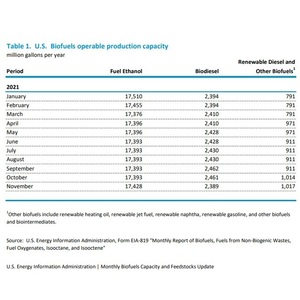EIA: Biofuel feedstock consumption up in November

January 31, 2022
BY Erin Krueger
U.S. ethanol and renewable diesel production capacity expanded in November while biodiesel capacity was down, according to data released by the U.S. Energy Information Administration on Jan. 31. Total feedstock consumption was up slightly when compared to the previous month.
Total U.S. operatable biofuels production capacity fell to 20.834 billion gallons in November, down 34 million gallons when compared to the 20.868 billion gallons of capacity reported for October.
Ethanol production capacity reached 17.428 billion gallons in November, up 35 million gallons when compared to the 17.393 billion gallons of capacity reported for the previous month.
Biodiesel production capacity fell to 2.389 billion gallons in November, down 72 million gallons when compared to the 2.461 billion gallons of operable capacity reported for October.
Advertisement
Advertisement
Capacity for renewable diesel and other biofuels, including renewable hating oil, renewable jet fuel, renewable naphtha, renewable gasoline and other biofuels and biointermediates, expanded slightly, reaching 1.017 billion gallons, up 3 million gallons when compared to the 1.014 billion gallons of capacity reported for the previous month.
Total feedstock consumption was up in November, reaching 28.083 billion pounds, up 7 million pounds when compared to the 28.076 billion pounds of feedstock consumed in October.
According to the EIA, 26.145 billion pounds of corn went to U.S. biofuel production in November, down from 26.204 billion pounds in October. Grain sorghum consumption was up, reaching 155 million pounds, compared to 69 million pounds in October.
An estimated 818 million pounds of soybean oil was used to produce biofuel in November, down from 832 million pounds the previous month. Corn oil and canola oil consumption were up, reaching 244 million pounds and 133 million pounds, respectively. In October, only 217 million pounds of corn oil and 116 million pounds of canola oil went to biofuels production.
U.S. biofuel producers also converted 347 million pounds of yellow grease, 112 million pounds of beef tallow, 49 million pounds of white grease and 17 million pounds of poultry fat into biofuel in November, compared to 321 million pounds, 141 million pounds, 67 million pounds and 15 million pounds, respectively, in October.
Advertisement
Advertisement
The EIA also reported that 63 million pounds of feedstock classified as “other” recycled feeds and wastes when to biofuel production in November, down from 64 million pounds in October.
The agency withheld data on a variety of other feedstock types, such as yard and food waste, other vegetable oils, and other fats and greases to avoid disclosing individual company data.
Additional data is available on the EIA website.
Related Stories
At the University of Missouri, plant biochemist Jay Thelen is using arabidopsis as a powerful model to explore ways to boost oil production — an important step toward creating more sustainable, plant-based energy sources.
Iowa farmers have a new market opportunity for their 2025 soybean crop. Landus is expanding its Clean Fuel Regulation initiative, made possible by recent policy changes expected to increase Canada's demand for liquid biofuel.
Topsoe, a leading global provider of advanced technology and solutions for the energy transition, has been selected as the renewable diesel technology partner for CountryMark’s Mount Vernon, Indiana refinery.
The U.S. exported 35,953.6 metric tons biodiesel and biodiesel blends of B30 or greater, according to data released by the USDA Foreign Agricultural Service on Aug. 5. Biodiesel imports were at 2,148.9 metric tons for the month.
XCF Global leverages Alfa Laval technology to enhance pretreatment capabilities at New Rise Reno facility
XCF Global Inc. on Aug. 5announced it leverages Alfa Laval Inc. pretreatment technology at its New Rise Reno biorefinery, a sustainable aviation fuel (SAF) plant located in Nevada. The pretreatment technology enhances feedstock flexibility at the plant.
Upcoming Events










